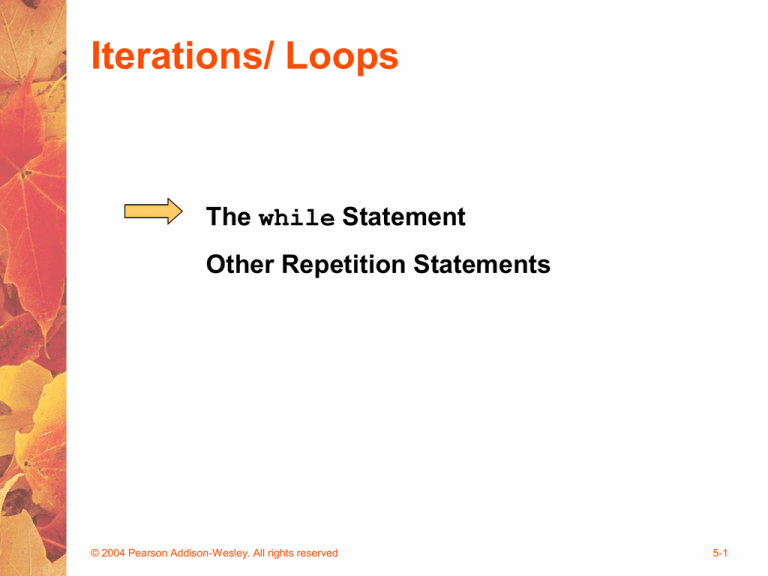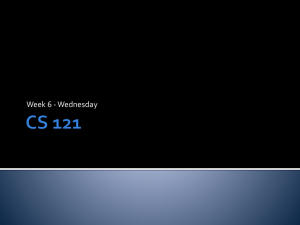
Iterations/ Loops
The while Statement
Other Repetition Statements
© 2004 Pearson Addison-Wesley. All rights reserved
5-1
Repetition Statements
• Repetition statements allow us to execute a
statement multiple times
• Often they are referred to as loops
• Like conditional statements, they are controlled by
boolean expressions
• Java has three kinds of repetition statements:
the while loop
the do loop
the for loop
© 2004 Pearson Addison-Wesley. All rights reserved
5-2
The while Statement
• A while statement has the following syntax:
while ( condition ){
statement;
}
• If the condition is true, the statement is
executed
• Then the condition is evaluated again, and if it is
still true, the statement is executed again
• The statement is executed repeatedly until the
condition becomes false
© 2004 Pearson Addison-Wesley. All rights reserved
5-3
Logic of a while Loop
condition
evaluated
true
false
statement
© 2004 Pearson Addison-Wesley. All rights reserved
5-4
The while Statement
• An example of a while statement:
int count = 1;
while (count <= 5){
System.out.println (count);
count++;
}
• If the condition of a while loop is false initially, the
statement is never executed
• Therefore, the body of a while loop will execute
zero or more times
© 2004 Pearson Addison-Wesley. All rights reserved
5-5
The while Statement
• Let's look at some examples of loop processing
• A loop can be used to maintain a running sum
• A sentinel value is a special input value that
represents the end of input
• A loop can also be used for input validation,
making a program more robust
© 2004 Pearson Addison-Wesley. All rights reserved
5-6
Infinite Loops
• The body of a while loop eventually must make
the condition false
• If not, it is called an infinite loop, which will
execute until the user interrupts the program
• This is a common logical (semantic) error
• You should always double check the logic of a
program to ensure that your loops will terminate
normally
© 2004 Pearson Addison-Wesley. All rights reserved
5-7
int count = 1;
while (count <= 25){
System.out.println (count);
count = count - 1;
}
• This loop will continue executing until interrupted
(Control-C) or until an underflow error occurs
Infinite Loops
© 2004 Pearson Addison-Wesley. All rights reserved
5-8
int count = 0;
while (count < 100) {
System.out.println("count:" + count);
}
forget to put in a line that changes count
Infinite Loops
© 2004 Pearson Addison-Wesley. All rights reserved
5-9
int count = 100;
while (count < 100) {
System.out.print(count);
count = count + 1 }
the test is false the very first time,
nothing is printed, comes out of the loop
© 2004 Pearson Addison-Wesley. All rights reserved
5-10
Nested Loops
• Similar to nested if statements, loops can be
nested as well
• That is, the body of a loop can contain another
loop
• For each iteration of the outer loop, the inner loop
iterates completely
• Your second course project involves a while loop
nested inside of a for loop
© 2004 Pearson Addison-Wesley. All rights reserved
5-11
Nested Loops
• How many times will the string "Here" be printed?
count1 = 1;
while (count1 <= 10){
count2 = 1;
while (count2 <= 20)
{
System.out.println ("Here");
count2++;
}
count1++;
}
10 * 20 = 200
© 2004 Pearson Addison-Wesley. All rights reserved
5-12
Outline
The while Statement
Other Repetition Statements
© 2004 Pearson Addison-Wesley. All rights reserved
5-13
The do-while Statement
• A do-while statement (also called a do loop) has
the following syntax:
do{
statement;
}while ( condition )
• The statement is executed once initially, and then
the condition is evaluated
• The statement is executed repeatedly until the
condition becomes false
© 2004 Pearson Addison-Wesley. All rights reserved
5-14
Logic of a do-while Loop
statement
true
condition
evaluated
false
© 2004 Pearson Addison-Wesley. All rights reserved
5-15
The do Statement
• An example of a do loop:
int count = 0;
do{
count++;
System.out.println (count);
} while (count < 5);
• The body of a do loop executes at least once
© 2004 Pearson Addison-Wesley. All rights reserved
5-16
Comparing while and do
The while Loop
The do Loop
statement
condition
evaluated
true
statement
© 2004 Pearson Addison-Wesley. All rights reserved
true
false
condition
evaluated
false
5-17
The for Statement
• A for statement has the following syntax:
The initialization
is executed once
before the loop begins
The statement is
executed until the
condition becomes false
for ( initialization ; condition ; increment ){
statement;
}
The increment portion is executed at
the end of each iteration
© 2004 Pearson Addison-Wesley. All rights reserved
5-18
Logic of a for loop
initialization
condition
evaluated
true
false
statement
increment
© 2004 Pearson Addison-Wesley. All rights reserved
5-19
The for Statement
• A for loop is functionally equivalent to the
following while loop structure:
initialization;
while ( condition ){
statement;
increment;
}
© 2004 Pearson Addison-Wesley. All rights reserved
5-20
The for Statement
• An example of a for loop:
for (int count=1; count <= 5; count++){
System.out.println (count);
}
• The initialization section can be used to declare a
variable
• Like a while loop, the condition of a for loop is
tested prior to executing the loop body
• Therefore, the body of a for loop will execute zero
or more times
© 2004 Pearson Addison-Wesley. All rights reserved
5-21
The for Statement
• The increment section can perform any calculation
for (int num=100; num > 0; num -= 5){
System.out.println (num);
}
• A for loop is well suited for executing statements
a specific number of times that can be calculated
or determined in advance
© 2004 Pearson Addison-Wesley. All rights reserved
5-22
The for Statement
• Each expression in the header of a for loop is
optional
• If the initialization is left out, no initialization is
performed
• If the condition is left out, it is always considered
to be true, and therefore creates an infinite loop
We usually call this a “forever loop”
• If the increment is left out, no increment operation
is performed
© 2004 Pearson Addison-Wesley. All rights reserved
5-23
break revisited
• Remember the break keyword that we used to
stop a switch statement from executing more
than one statement?
• break can also be used to exit an infinite loop
• But it is almost always best to use a well-written
while loop
© 2004 Pearson Addison-Wesley. All rights reserved
5-24







